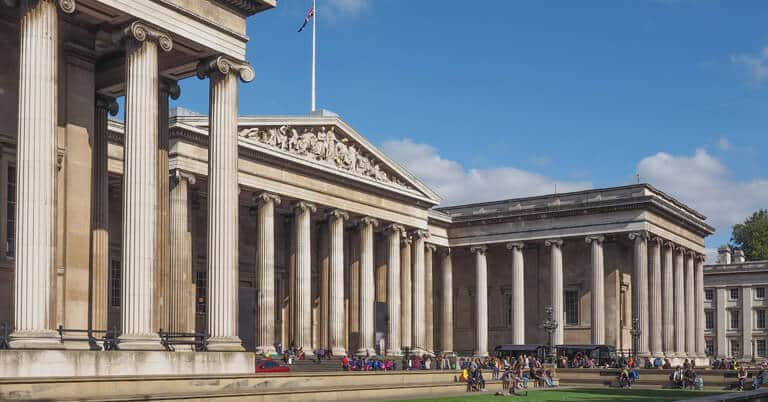The British Museum is one of the most famous and important museums in the United Kingdom. Located in Great Russell Street, London, it attracts an estimated six million visitors every year to view its seven million fascinating exhibits. The museum is open seven days a week and admission is free.
Established in 1753, it first opened to the public in 1759. Initially, it housed the collections of the Ulster-born scientist and doctor Sir Hans Sloane, who lived in London and gathered a massive array of curiosities. He didn’t want his collection of 71,000 objects from all over the world to be broken up after his death.
In his will, he bequeathed everything to King George II, for the nation, for the sum of £20,000. The king gave the royal assent on 7th June 1753 to establish the British Museum. Sloane’s collection included all kinds of artefacts from all over the world, collected during the time of the British Empire.

© Claudio Divizia / Adobe Stock
Lindow Man
There were 40,000 printed books, 337 volumes containing drawings, prints and dried plants of natural history specimens, 7,000 manuscripts and antiques from Egypt, Sudan, Greece, Rome, the Far East and the Americas.
During the next 250 years, the museum expanded and amassed some of the most popular and significant historic finds in the world. These include the oldest mummy, the Lindow Man. The preserved body was unearthed in a peat bog on 1st August 1984 by commercial peat cutters working at Lindow Moss, in Cheshire.
The accidental find caused a media sensation. Scientists estimated the body dated from between 2 BC and 119 AD. Lindow Man had been in his mid-20s and appeared to be of noble birth, as there was no sign he had done manual labour. Much debate ensued over the cause of his death, with some suggestions it had been violent and may have been ritualistic.
Rosetta Stone
The British Museum also houses the Rosetta Stone, which dates from Egypt in 196 BC. It is believed to have been on display in a temple at Sais, near where it was found in 1799, on the outskirts of the Egyptian port of Rosetta. It was discovered by French soldiers of an expeditionary army who had been deployed to Egypt.
The stone is inscribed with a decree, issued by King Ptolemy V, in three different languages, including hieroglyphs. According to reports, it was “captured in Egypt by the British Army” in 1801 and was presented to the British Museum in 1802, where it has been displayed ever since.
By the end of the 19th century, the museum was such a popular visitor attraction that it was given its own tube station. Construction began in 1898 and it officially opened in 1900. However, it closed in September 1933 after Holborn Station opened, less than 100 yards away from the museum.
Museum expansion
Over the years, the museum gathered such a large number of artefacts that a second site opened in the 1880s. Many of the items were moved to the Natural History Museum in South Kensington, which was originally known as the British Museum (Natural History).
In addition, a huge number of books and manuscripts were moved to a third site, the British Library, based on Euston Road. Antiquities there include the sole surviving manuscript of Beowulf – the old English epic poem dating from 975 to 1025 – and the Lindisfarne Gospels, produced between 715 and 720.
Electric lighting
The museum was one of the first buildings to have electricity. Up until the late 19th century, it had to close early in winter when nightfall came, as it was lit by natural daylight. Candles, gas lamps and oil lamps weren’t permitted due to the fire risks.
Electric lighting was pioneered in the Front Hall, the Reading Room and the Forecourt in 1879, enabling parts of the museum to stay open until 7pm, even in winter. By 1889, the electric lighting system had advanced and was used in almost all of the public areas.
Famous cat
The museum is known for some typically British and rather endearing touches, such as the tradition of having a museum cat. There have been many cats living there over the years, the most famous being Mike, who was the resident feline from 1909 to 1929. He became so famous that when he died, his obituary appeared in Time Magazine and the Evening Standard.
The museum is also famous for having been a film set an amazing 15 times! Among the most famous were the thriller Day of the Jackal in 1973 and the comedy adventure, Night at the Museum: Secret of the Tomb, in 2014.
If you’re planning a visit to the British Museum, check out H&H Van Hire’s affordable weekend minibus hire. Please contact us for further details of our comfortable nine, 14 and 17-seater minibuses.


